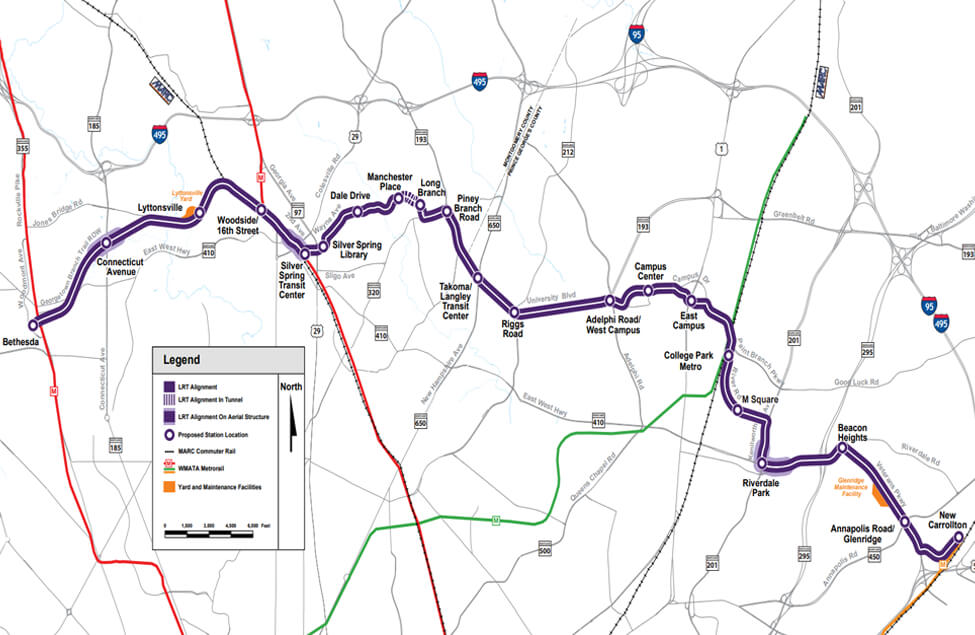Transportation influences development patterns, where people live and work, and environmental quality. With significant operations, assets, and employees in the National Capital Region, the federal government relies upon, and affects, the regional transportation system. While the region is a leader in innovative transportation solutions, it still faces continued growth, congestion, and aging infrastructure issues. NCPC develops policies and addresses transportation in its long-range planning. We encourage multi-modal transportation strategies as an important part of our review of federal plans and development.
Highlight: Transportation Element Update
The monitoring program was introduced in the element, with details in its addendum. The effort is intended to acquire up-to-date metrics from federal installations/facilities as transportation demand management strategies are implemented and will occur on a biennial basis.
The draft element provides policy guidance to support a regional multimodal transportation system that promotes responsible land use and development and contributes to a high quality of life for residents, workers, and visitors. NCPC uses Comprehensive Plan policies as the primary guide when reviewing federal projects and plans. NCPC Staff anticipates bringing a final draft of the element to the Commission for approval this summer.

NCPC Key Guidance

Transportation Element
The current element's policies will remain in effect until the updated element is adopted by the Commission. The element promotes a multi-modal regional transportation system that meets the travel needs of workers, residents, and visitors, while improving regional mobility and air quality through transit-oriented development. It includes policies and parking ratios used by NCPC staff to evaluate transportation as part of its review of master plans and other federal facilities. Staff is currently updating the element to include parking study findings and address new transportation and workplace trends, as well as new transportation options.

Transportation Management Plan Handbook
Transportation Management Plans (TMPs) are required for federal projects that will increase employment on a work site to more than 500 employees, and are strongly encouraged for sites with more than 100. The handbook provides federal agencies with procedures and guidelines to prepare a TMP that documents the agency’s program to foster more efficient employee commuting patterns. NCPC requires a TMP for all master plan updates.
NCPC Transportation Initiatives
-

Pennsylvania Avenue Initiative
The initiative is an interagency effort to improve Pennsylvania Avenue’s economic health, physical conditions, and operations. This involves examining how to reallocate underused roadway caused by a decrease in traffic since the closure of E Street and Pennsylvania Avenue near the White House.
-

Monumental Core Streetscape Project
Initially produced in 1992 and updated in 2013, the Streetscape Manual provides guidelines for a coordinated and consistent streetscape treatment for roadways and associated sidewalks in Washington’s central area near the National Mall. The Monumental Core Streetscape Project is an interagency initiative to update the Streetscape Manual to further connect the National Mall and tie the capital city together through its public realm and streetscapes. NCPC will use the new manual to review future submissions. As part of this effort, NCPC will update lighting standards in the monumental core and coordinate with the city’s Smart Street Lighting Project.
-

Federal Parking Study
Conducted in conjunction with the U.S. Department of Transportation's Volpe National Transportation Systems Center, the study examined NCPC’s policies, reviewed national and local parking practices, and included a modeling analysis. The study found that NCPC’s current parking ratio approach is valid, but could benefit from refinements; recommended developing a consistent process and criteria to consider requests by federal agencies to vary from the parking ratios; and suggested a regular monitoring program to measure agency progress towards meeting parking ratios. The Commission directed staff to use its findings to evaluate potential changes to the Transportation Element.
-

SW Ecodistrict Plan
The plan’s overarching goals are to achieve a high performing, well-connected neighborhood and cultural destination. Improving the transportation network is a key component. This involves reconnecting the street grid, including reestablishing Maryland Avenue as an urban boulevard, expanding the rail corridor and L’Enfant Station, and transforming 10th Street, SW into a walkable cultural corridor.
-

White House Area Transportation Study
Conducted by NCPC and the Federal Highway Administration in 2011, the study examined ways to address traffic problems near the White House, including congestion that resulted from area street closures. The study evaluated the downtown transportation system's overall health and resiliency, and reports on potential actions to compensate for the closures.
-

Monumental Core Framework Plan
One of the plan’s key themes was improving connections, such as between the National Mall and the waterfront and the National Mall and downtown. It focused not only on transportation connections, but also on ways to make these connections more attractive and pedestrian-friendly.
-

Freight Railroad Realignment Feasibility Study
The exploratory study, a joint effort between the District Department of Transportation and the National Capital Planning Commission, was funded by a $1 million grant from the Department of Homeland Security’s Urban Area Security Initiative Program. The ideas from the study are no longer under consideration because a different option was chosen.
-

Circulator
A convenient, low cost and easy-to-use transit service that began operations in July 2005. First introduced in the NCPC’s 1997 Legacy Plan, this transit service now provides six routes, including a National Mall route.
-

Extending the Legacy: Planning America's Capital for the 21st Century
A major component of the Legacy Plan involved improved transportation. Redeveloping North and South Capitol Streets as civic gateways, and making East Capitol Street a major link between the core and the communities east of the Anacostia River, were important themes. Concepts for a Circulator and water taxis are examples for improving mobility.
-

WMATA Compact
Signed by the District of Columbia, the State of Maryland, and the Commonwealth of Virginia, it created the Washington Metropolitan Transit Authority, which would “plan, develop, finance and caused to be operated a comprehensive mass transit system for the Washington Metropolitan Area.”
-

A Transportation Plan for the National Capital Region
One of the important early steps in the future Metro system's development was the congressionally directed Mass Transportation Study conducted by NCPC. Begun in 1955, the resulting A Transportation Plan for the National Capital Region recommended, among other things, the creation of a 33-mile rapid transit system.
Emerging Transportation Trends
Recent Project Reviews
NCPC’s review work ranges from reviewing TMPs for federal facility master plans to impacts on federal transportation assets (such as parkways) to commenting on the historic and environmental impacts of regional transportation projects.
Regional Transportation Efforts
Move DC
A collaborative effort led by the District Department of Transportation to develop a bold and implementation-focused vision for Washington’s transportation future.
WMATA
The Washington Metropolitan Area Transit Authority oversees the six-line Metrorail subway system and the 170-line Metrobus system. According to WMATA, 35 Metrorail stations serve federal facilities, while 39 percent of Metrorail and 16 percent of Metrobus peak period commuters are federal employees. The Silver Line is the system’s latest expansion—the first segment opened in 2014 and the second will in 2020.
Momentum Strategic Plan 2013-2025
A strategic plan to guide WMATA's Metrorail decisions to ensure that the system continues to support the region's competitiveness for decades to come.
Transportation Planning Board
The National Capital Region Transportation Planning Board is the federally designated metropolitan planning organization for metropolitan Washington. Working with local, state, regional, and federal partners, it coordinates future plans; provides data and analysis to decision makers; and coordinates regional programs to advance safety, land-use coordination, and more. The Metropolitan Washington Council of Governments houses and staffs the board. NCPC is an ex-officio member.
Visualize 2045
A long-range transportation plan for the National Capital Region developed by the Transportation Planning Board documenting more than 1,000 projects and improvements the region’s transportation agencies are planning through 2045. It includes what they can afford now (previously included in the Constrained Long-Range Transportation Plan) and what they would build with additional funding.







